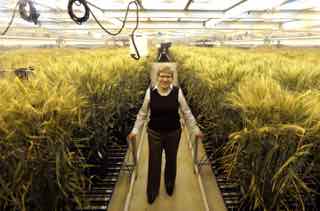GMO-Brainer?

Dr. Claire CaJacob, Global Wheat Technology Lead, poses for a portrait inside a growth chamber with three month old wheat on Thursday, Jan. 8, 2014, at Monsanto’s Chesterfield Village Research Center near St. Louis. The growing conditions simulate a summer day in North Dakota. Monsanto is once again pursuing development of genetically modified wheat – something it abandoned in the 1990s after meeting stiff resistance from farmers worried about consumer reaction. (Laurie Skrivan/St. Louis Post-Dispatch/TNS)
In an ABC News telephone study of over one thousand adults, 52% of those surveyed believed that genetically modified foods are unsafe. Additionally, 93% believed that the FDA should require labels marking that a food is genetically modified. However, no such labels exist.
Genetically modified organisms, also known as GMOs, are organisms, which have had their genetic material manipulated in a laboratory. These organisms can contain combinations of genes from plants, animals, bacteria, and viruses. The result of modern organism modification would not occur in nature or through typical cross-breeding methods.
Take strawberries for example: many strawberries will contain genes from the arctic flounder, a cold-water fish, to provide anti-freeze characteristics to strawberry plants. Sounds tasty right?
More recent technology enables scientists to modify organisms without crossbreeding or selective breeding. Instead, scientists can use gene splicing and directly insert genetic material from one organism into another. In the market today, the most commonly genetically modified crops are alfalfa, canola oil, corn, cotton, papaya, soy, squash, sugar, and zucchini.
There is a lot of debate on the pros and cons on genetically modified organisms and if they are harmful or helpful, with countless studies to back up both sides and create a stalemate in the debate.
Over the past many years, many countries around the world have put a ban on genetic modification or mandated that companies at least label their genetically modified products. Many wonder when and if the United States will ever follow such procedure and question the safety of eating genetically modified foods.
A study done by the Institute for Responsible Technology (IRT), in 2013, claims the consumption of genetically modified foods is linked with the increase of gluten sensitivity in consumers.
Gluten is a protein composite, which can be found in wheat, barley, and rye. Gluten sensitivity or gluten intolerance can range from a mild discomfort to a very serious digestive condition, Celiac Disease. Although wheat is not a commonly genetically modified crop, the components of other crops are the main concern.
Many genetically modified crops are modified to produce an insecticide called Bt-toxin. The pro of infusing a crop with an insecticide is that if an insect were to try to eat it, the insect would die. However, the insecticide stays in the food when it is shipped to our supermarkets and placed on dining room tables.
This fact may make GMOs seem completely terrible, but they also carry benefits to society. With genetically modified crops, land can be used more efficiently and plants produce more crops with less failure. Plants can also be engineered to produce foods to be more appealing to humans by improving the texture, flavor, and nutritional value of foods.
Scientists have also experimented with genetically modified foods to create edible vaccines. Although there is controversy, as expected, over genetically modified foods to create vaccines, in the future vaccines may be delivered by having a patient consume certain fruits or vegetables as an alternative to injectable vaccines.
Both positive and negative effects result from genetically engineering organisms. The debate over genetically modified organisms likely won’t end anytime soon and could likely become an even bigger part of the future.











